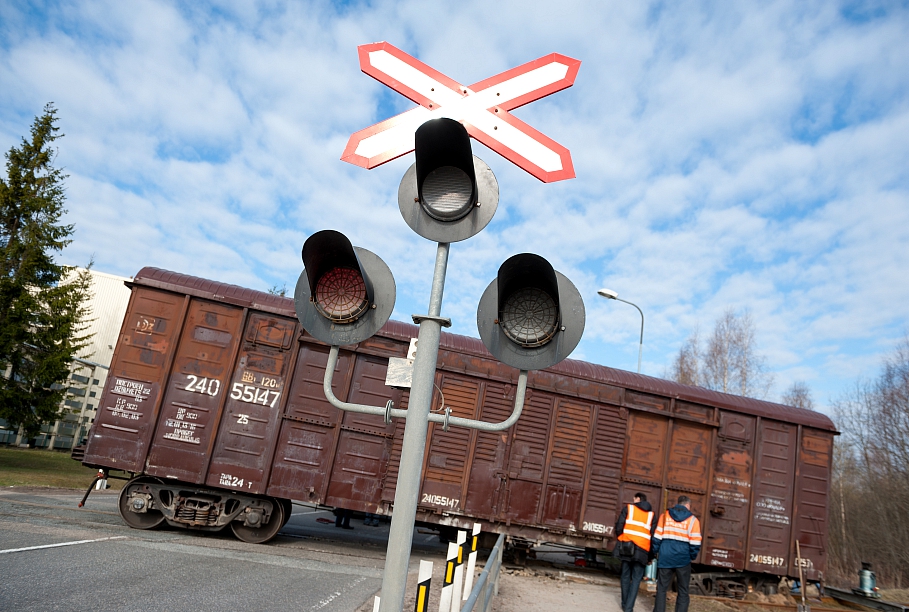Rail Baltica
Rail Baltica is a proposed high-speed line to link Helsinki with Berlin through the Baltic capitals by 2024.
The part running through Latvia is estimated to be about 265 kilometers long and cost €1.27b, of which 80-85% would be covered by EU funds.
However, rus.lsm.lv was told at the Polish Ministry of Infrastructure and Development that "It does not mean, however, that the project would not be implemented at all"
The Polish government approved a national program for railway investment until 2023 on September 15. The cost of all its projects sits at PLN 67.5 billion (about €15.9b).
The implementation of the programme is primarily aimed at shortening the train travel time on the railway routes managed by PKP Polskie Linie Kolejowe SA, the company responsible for maintenance of rail tracks, conducting the trains, and management of railway land in Poland.
The plan includes lengthening sections of railway lines allowing passenger trains to travel at a speed over 160 km/h.
The track from the border station of Trakiszki to the nearest large city - Białystok - is, to put it mildly, in an unfavorable condition for fast-speed trains that, according to the Rail Baltica project, should run through the Tallin-Rīga-Kaunas-Warsaw-Berlin track with the average speed of above 120 km/h.
 The Trakiszki-Białystok line, as Rus.lsm.lv found out at the Ministry of Infrastructure and Development, runs for 204 kilometers. Its current speed limits are 120 km/h for passenger trains and 100 km/h for freight trains.
The Trakiszki-Białystok line, as Rus.lsm.lv found out at the Ministry of Infrastructure and Development, runs for 204 kilometers. Its current speed limits are 120 km/h for passenger trains and 100 km/h for freight trains.
However, about a quarter of the track has a speed limit of 30 km/h (the Olecko–Suwałki line), and only the Białystok–Ełk section - about half of the course - has been electrified.
The technical condition of tracks is good for 69.5% of the section’s length, meaning it only requires some maintenance, for 3.3% it is satisfactory, with speed limits and requiring a replacement of up to 30% pavement elements, and at 27.2% it is unsatisfactory, needing comprehensive pavement replacement and with a considerable reduction of timetable speed.
The first tenders for the amount of PLN 11 billion (about €2.6b) are to be announced this year already, and to be spent in the next years at about the same speed. However, a representative of the Ministry of Infrastructure and Development told rus.lsm.lv that there are no plans for reconstruction and modernizing the Trakiszki-Białystok section.
"The project is on the National Railways Plan (NRP) reserve list. The NRP division into the basic and reserve list is the effect of available allocation of European Union funds for 2014-2020 and national funds that can be involved," told a representative of the ministry.
However, this doesn't mean that the project will be scrapped altogether.
The ministry said that if "adequate funds are obtained" by generating savings during the implementation of the projects on the basic list, or with money from from the European Connecting Europe Facility fund pool, the project can be realized after all.
Though even if some funds are saved during the project, there's no guarantee that they'll be spent on the Rail Baltica section by the border: "Projects will be selected according to their degree of preparation and the total pool of available funds. [..] PKP PLK S.A. is performing preparatory works for some of these projects. Thus, when funds are released, it will be possible to immediately submit an application for co-financing and launch project implementation. This is the case with the Rail Baltica section Białystok–Trakiszki.
The Ministry of Infrastructure and Development said that at the moment a feasibility study, planned to be completed in April 2016 is underway, and whether funding will be allotted to the line depends on its results. If funds in sufficient amount are obtained, construction works could be carried out between 2018 and 2021.
The Polish-Lithuanian border where Rail Baltica should cross it. Lithuania is on the right, while Poland is on the left. (Source: Google Maps)
While the fate of the Warsaw–Białystok line, the second block of the Polish part of Rail Baltica, is a lot less murky.
The project is divided into two parts, and both are on the basic list of projects. More than a third of the required funds for the Warsaw–Tłuszcz (Sadowne) line have been allotted already, and the reconstruction of the line should be carried out next year. The reconstruction of the second part, from Sadowne to Białystok should start in 2017 and be finished in 2020.
While high-speed trains are already running from Warsaw to Berlin. The capital of Poland is connected with the capital of Germany with trains that beat about 600 kilometers in 5 hours and 30 minutes.
Rail Baltica is a proposed high-speed line to link Helsinki with Berlin through the Baltic capitals by 2024.
The key goal of the project is to renew regional integration by re-joining the Baltic states with the European rail network.
The project will cost Latvia about 1.27 billion euro. It is co-funded by Connecting Europe Facility (CEF). The first part of the project acquired more than 80% in funding from the CEF.






























